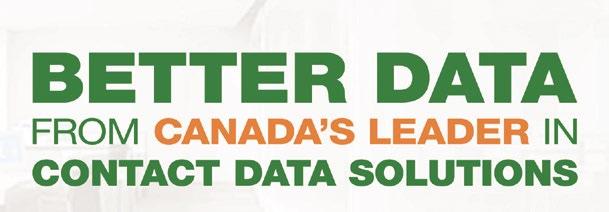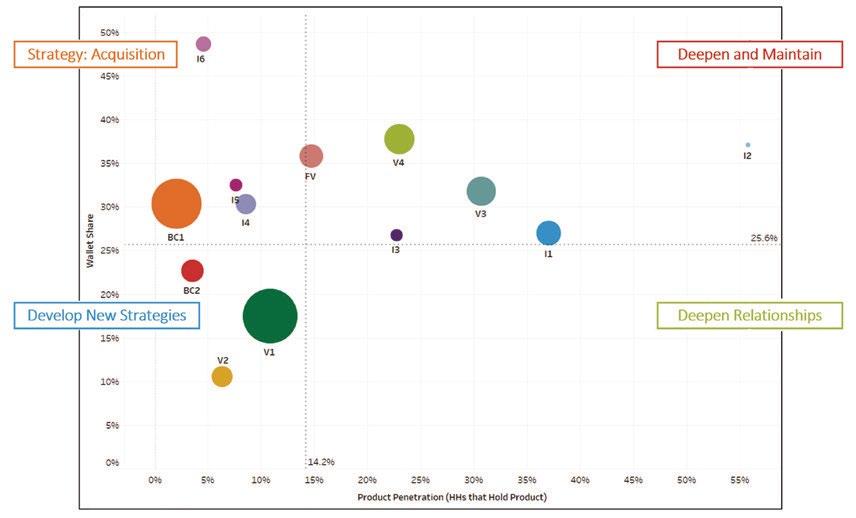Interview with Scott Goodson on Brand Activism
Being data-driven is complicated. We can help.



VOL. 35 • NO. 11 • NOVEMBER 2022 THE AUTHORITY FOR THE DATA-DRIVEN BUSINESS PM40050803 ❱ 8
❱ 18 Flying
Future-Proofing Your Budget
+
GREENBUTTERFLY
Blind:
BRANDS + RESEARCH
TECHNOLOGY ISTOCK/
We’ll Help You Keep It Clean

Melissa.com 800.MELISSA (635-4772) Trust the Address Experts to deliver high-quality address veri cation, identity resolution, and data hygiene solutions.
Dealing with bad data is a task no marketer needs on their checklist. Inaccurate, outdated, and duplicate records can build up in your database, affecting business decisions, the customer experience, and your bottom line.
Address Experts, Melissa helps our customers improve their direct marketing efforts with the best Address Veri cation, Identity Veri cation and Data Enrichment solutions available. We validated 30
records
which is why thousands of businesses worldwide have trusted us
their data quality
Contact us for a Free Proof of Concept and ask about our 120-day ROI Guarantee. BAD DATA BUILDUP Missed Opportunities Returned Mail & Packages Decreased Customer Insight Real-time Address Veri cation Change of Address/NCOA Processing Geographic & Demographic Data Appends DATA CLEANLINESS
As the
billion
last year alone,
with
needs for 37+ years.
PRESIDENT Publisher & Editor-in-Chief
Steve Lloyd - steve@dmn.ca
DESIGN / PRODUCTION




Jennifer O’Neill - jennifer@dmn.ca
ADVERTISING SALES



Steve Lloyd - steve@dmn.ca

CONTRIBUTING WRITERS
Mo Dezyanian
Jill M. Speirs Are Traasdahl













LLOYDMEDIA
Phone: 905.201.6600 Fax: 905.201.6601 • Toll-free: 800.668.1838 home @dmn.ca • www.dmn.ca
EDITORIAL CONTACT:

DM Magazine is published monthly by Lloydmedia Inc. DM Magazine may be obtained through paid subscription. Rates: Canada 1 year (12 issues $48) 2 years (24 issues $70) U.S. 1 year (12 issues $60) 2 years (24 issues $100)
DM Magazine is an independently-produced publication not affiliated in any way with any association or organized group nor with any publication produced either in Canada or the United States. Unsolicited manuscripts are welcome. However unused manuscripts will not be returned unless accompanied by sufficient postage.
Occasionally DM Magazine provides its subscriber mailing list to other companies whose product or service may be of value to readers. If you do not want to receive information this way simply send your subscriber mailing label with this notice to:
Canadian





Canada Post

// 3 NOVEMBER 2022 DMN.CA ❰ Vol. 35 | No. 11 | November 2022
Bastin Gerald Stephen Shaw INC. HEAD OFFICE / SUBSCRIPTIONS / PRODUCTION:
302-137 Main Street North Markham ON L3P 1Y2
Publications Mail Sales Product Agreement
Twitter: @DMNewsCanada FINANCE INTERVIEW ANALYTICS NEXT ISSUE: Our 2023 Forecast & Insights MANAGEMENT ❯ 6 Using Data to Make Effective Ad Buys How Marketers Can Move from the Proxy of KPIs to ROI ❯ 7 Accelerating Business Change and Marketing Transformation with Technology ❯ 8 Brand Activism: Interview with Scott Goodson, Founder and CEO, StrawberryFrog TECHNOLOGY ❯ 4 Talking Points talkingpoints ❯ 14 Top 10 Marketing Agency Metrics to Measure: A Fast Refresher ❯ 18 FLYING BLIND Have marketers lost their ability to future-proof their budget? ❯ 20 Canada Retail Report: Trends for 2022 How payments continues to drive in-store shopping, loyalty programs, and insights to shape, grow retail ambitions for 2023 and beyond INSIGHTS BRANDS + RESEARCH + TECHNOLOGY ISTOCK/ GREENBUTTERFLY ISTOCK/GORODENKOFF ISTOCK/ RUDZHAN NAGIEV ISTOCK/ PEERAKORN CHOTTHANAWARAPONG
Lloydmedia Inc. 302-137 Main Street North Markham ON L3P 1Y2 Canada. POSTMASTER: Please send all address changes and return all undeliverable copies to: Lloydmedia Inc. 302-137 Main Street North Markham ON L3P 1Y2 Canada
No. 40050803
❯
talkingpoints
36 percent of Canadian customers prefer retailers who use previous shopping behaviour to serve personalized suggestions and create a more tailored shopping experience.
For a full examination of these trends, see the feature in this issue on page 19. ■
Five Keys to Getting a Marketing Budget Approved in 2022
A new study called FLYING BLIND - Have marketers lost their ability to future-proof their budget? looks at the relationship between CMOs and CFOs in the budgeting process.

This study by Empathy Inc and sponsored by Leger, AMA Toronto and the CFO Centre explores who today’s economy and markets affect the crux of the relationship between marketing and finance and a delicate balancing act of short- versus long-term. And in the unpredictable postCOVID world, how that balancing act becomes increasingly difficult.
Finance is still unsure whether you have the right information to determine your success.
You can read the full study and commentary and insights in this issue on page 22.
Can Fraud Kill Marketing Campaigns?
LexisNexis Risk Solutions released the results of its annual True Cost of Fraud Study: Financial Services and Lending report. The sixth edition of the report examines current fraud trends for more than 500 United States and Canadian financial services and lending companies and highlights key pain points related to the addition of new payment mechanisms, online and mobile channel transactions and international expansion.
Key highlights include: True Cost of Fraud: U.S. and Canadian financial services firms’ fraud costs continue to rise. Every $1 lost to fraud now costs U.S. financial services firms $4.23 compared to $3.64 in 2020, a 16.2 percent increase. The cost for Canadian financial services firms rose 19.6 percent, from $3.16 in 2020 to $3.78 in 2022.





Key Findings
Retail in-store Experience is Back Baby
















New data released finds that the retail experience is back with bells, whistles and unified commerce. Adyen’s first Canada Retail Report shows that 67 percent of Canadian customers in 2022 prefer to shop in-store, and 50 percent look for an experience beyond just the product. The shift from online back to in-store indicates that retailers need to double down on unified commerce solutions in order to prepare for, and ride out, the retail storm and quickly pivot to the changing behaviours of shoppers.

Adyen, a leading retail end-to-end, allin-one payments solution for merchants across the globe, is shaping the newly emerging ”unified commerce” industry. The report highlights trends to watch in the payment technology industry, insights into the integrated world of physical and online shopping, and ultimately, what financial advisors should keep in mind when it comes to the world of recreational spending.
Other report highlights:
❯ 56 percent of customers would be more likely to use a retailer’s loyalty program if it automatically linked with their payment card.
❯ 60 percent of consumers would be more loyal to a retailer if they could return their online items in store


Here’s a highlight, which suggests the 5 keys to the relationship:
1. Two years ago marketing and finance were aligned on budget timing. Now, budgeting is rushed. As difficult as it may be, aim to start collaborative budgeting earlier, at least 4-6 months before fiscal end.
2. Forecasting has become the marketer’s number one budgeting challenge in 2022. We recommend that both departments leverage each other’s core strength. Marketing can tap into finance’s forecasting capabilities; finance can benefit from marketing’s proximity to the customer.
3. Balancing the long and short terms will forever be a point of tension between CMOs and CFOs; the past two years have exasperated that tension. Yes, outlining the long-term effects of marketing for finance is critical now. But don’t forget about the short-term!
4. Two years ago we suggested that you invest in resources to extract insights from the market (via market research), the competition (competitive research), bolstered by available data in your organization. Today we explicitly recommend that you divest from data infrastructure and invest in insights and research talent.
5. It is now more than ever important that marketers get alignment with finance about what the KPIs are in the future.
Attacks and Costs: Fraud costs and attack volumes for financial services firms remain significantly higher compared to before the pandemic. Costs continued to rise above early 2020 levels, with banks reporting the highest figure of $4.36 for every $1 of fraud loss. Mortgage firms also had a comparably higher cost of $4.20 for every $1 lost to fraud.
Trends to Watch: Fraudsters targeting mobile channels, increased bot attacks, various scams and the rapid adoption of buy now, pay later (BNPL) are causing concern for financial services and lending firms. Mobile channels now generate a sizeable level of transaction volume and fraud costs. Banks and credit lenders are beginning to accept BNPL as a digital payment method, which respondents indicated represents one-third of the overall average transaction volume.
Scams Impacting Customer Journey
Risks: Scams are contributing to increased fraud costs, particularly creating more risk at the new account creation stage of the consumer journey. Scams impact fraud detection across consumer touch points by heightening challenges associated with digital identity verification, distinguishing bots from legitimate customers and balancing fraud detection with customer friction. Those dealing with multiple types of scams had a higher cost of fraud based on more labour/ investigation efforts.
Identity-Related Fraud: Lack of identity verification is a top challenge that contributes to fraud across the customer journey. With
// 4 ❱ DMN.CA NOVEMBER 2022
■ ■ ■ ■ ■ ■ ■ ■ ■ ■ ■ ■ ■
■ ■ ■
■
■ ■ ■ ■ ■ ■ ■ ■ ■ ■ ■ ■ ■ ■ ■ ■ ■ ■
new account creation still trending upward, U.S. banks that deal with multiple types of scams attributed more identity-related fraud to new account creation. Canadian lending firms and U.S. mortgage lenders saw the biggest increase in identity-related fraud across account creation, with a 9 percent rise and 11 percent rise respectively since 2020.
“It’s clear that fraud has become more complex with various risks occurring simultaneously,” said Chris Schnieper, senior director of fraud and identity strategy, LexisNexis Risk Solutions. “To minimize fraud, organizations can no longer rely on manual processes or point solutions to reduce fraud, manual reviews and costs. Firms using a multilayered solutions approach that integrates identity verification and authentication within digital consumer experience can lower their cost and volume of successful fraud. This approach improves identity verification and fraud detection effectiveness and lowers friction for trusted consumers.”
recipes and fuel powered by BioSteel, The Lounge where CCM history is on display through the first gear used in the game to today’s high tech offerings, and The Rink Of Dreams where players experience the ultimate outdoor rink in the newest gear putting their skills to the test in a series of combine challenges.
“We’re excited to inspire consumers by creating a hockey space like Toronto has never seen. This CCM experience will introduce the game to kids that have never had the opportunity to experience it before, give hockey players a taste of the Pro-life, all while having fun and building a foundation to take their game to the next level. We believe that after this event Torontonians will be energized and motivated to enjoy the game even more!” Robert Zaring, VP Marketing, CCM Hockey.
“The Hockey house is just another example of the creative and innovative ways CCM is growing the game of hockey. For youth from both the HDA & the TTD Foundation to get this experience and to interact and get to know the CCM brand is invaluable in diversifying and expanding the reach of the sport of hockey.” Akim “Dreamer” Aliu, Chairman, Hockey Diversity Alliance.
Association (CMA). Presented at a gala ceremony, the award recognizes the immeasurable contributions and impact that Jan has made in developing best-in-class data and analytics for the marketing community.
This is the first time that the CMA’s Lifetime Achievement Award has been presented to a female data scientist, and follows Jan’s recognition as one of 14 Canadians recognized in the top 250 leaders globally through Insight250—a ranking published by the European Society for Opinion and Market Research (ESOMAR)—for her contributions in elevating and enhancing market research, data-driven marketing and enterprise business intelligence.
“I am incredibly honoured to receive this recognition, particularly as a woman in STEM,” says Jan Kestle. “It demonstrates the importance of data-driven decision making, not only in marketing but for the overall well-being of Canada. With life and business advancing at an ever-accelerating rate, it’s so gratifying to see the adoption of data and analytics everywhere.”
Jan built a career on a simple but profound truth: that we can improve the lives of Canadians through transformative data and analytics by using statistics and mathematics to help solve business problems and improve society.
Offering the best gear and on-ice experience to Toronto

CCM Hockey, a leading designer, manufacturer and marketer of hockey equipment, is excited to announce that it has transformed one of Toronto’s largest homes into an immersive hockey experience called CCM Hockey House from Nov 17th- 20th. CCM Hockey House will be a space dedicated to player improvement and give the Toronto hockey community access to one of the most exciting hockey experiences yet — from the latest tech and performance to hitting the ice on one of the most beautiful private rinks in the city.
Located in Armour Heights, the CCM Hockey House is an immersive hockey experience intended to help the next generation of players level up. This is not your regular house; CCM has transformed every room into spaces dedicated to player improvement. The house features: The Locker Room with the most advanced gear in the game and chill out zones to play NHL 23’ from EA Sports, The Kitchen for game changing
CCM Hockey is a leading designer, manufacturer and marketer of hockey equipment. With its headquarters located in Montreal, the company has operations in Canada, the United States, Europe and Asia. CCM Hockey equips more professional hockey players than any other company, including superstars like Auston Matthews, Connor McDavid, Matt Dumba, Sidney Crosby, key female players such as, Kendall Coyne-Schofield and Sarah Nurse and top performing Goalies such as Jacob Markstrom, Thatcher Demko, Philip Grubauer and Maddie Rooney. CCM Hockey is also the official outfitter of the American Hockey League, the Canadian Hockey League, and several NCAA and National teams.
Jan Kestle
recognized for a lifetime of success
President of Environics Analytics, Jan Kestle, has received the Lifetime Achievement Award from the Canadian Marketing
“We are thrilled to present Jan with the CMA’s Lifetime Achievement Award. She has been a pioneer in insights and analytics, and a mentor and an inspiration to countless marketers throughout her career,” said Sartaj Sarkaria, Chief Operating Officer and Chief Diversity Officer, CMA. “Her support to the CMA community is immeasurable through her many roles over the years, including board director, chair of multiple committees and councils, and champion of many of our initiatives.”
Jan has been a leader in the marketing information and statistics communities for five decades. She is a member of the Canadian Statistics Advisory Council, the Board of the Morrisette School for Entrepreneurship at Western University and serves on the Dean’s Advisory Boards of TMU’s Ted Rogers and McMaster’s DeGroote business schools.
Environics Analytics (EA) is the premier marketing and analytical services company in Canada, helping thousands of customers across every industry sector turn data and analytics into strategy, insights, and results. Established in 2003, we specialize in using best-in-class data, analytics expertise, and purpose-built software (including software-asa-service platforms ENVISION and SPOTLIGHT) to address key challenges in areas such as consumer profiling and segmentation, multichannel media planning and execution, trade area analysis, merchandising strategies and site location decision-making. Environics Analytics is a Bell Canada company.

// 5 DMN.CA ❰ NOVEMBER 2022
■ ■ ■ ■ ■ ■ ■ ■ ■ ■ ■ ■ ■ ■ ■ ■ ■ ■
■ ■ ■ ■ ■ ■ ■ ■ ■ ■ ■ ■ ■ ■ ■ ■ ■ ■
Using Data to Make Effective Ad Buys How Marketers Can Move from the Proxy of KPIs to ROI
BY ARE TRAASDAHL
Programmatic advertising, where I spent a significant amount of time in my career, now accounts for 85 percent of all digital ad spending. It’s hard to imagine how marketers lived without it: automating media buys in response to real-time market signals was key to targeting the right people at the right moment.
But for brand marketers, even these technological advances have left gaps between the digital advertising world and the reality of store shelves. Those gaps create situations where at best, advertising ROI is unproven and at worst, ad dollars are spent where products aren’t even in stock.
Programmatic advertising at its best is all about efficiency. It’s time to focus on a new stage: efficacy. And for that we need to focus on real ROI, linking media buys with actual product performance.
It’s time now to integrate existing programmatic ad buy systems with retail data to facilitate successful program execution and evaluation based on real-time, on-shelf data. We can use advanced algorithms to better identify, define, and reach target consumers, connect demand with supply, flag potential disruptions, predict store and online traffic, track inventory and product performance, trigger production requirements, optimize fulfillment options, understand store conditions, and replenish both virtual and in-store shelves at speed and scale. Rather than focusing on the KPIs of CPM, CTR and other proxy metrics measuring the ‘success’ of an ad campaign, I encourage brands to focus on the metrics that investors truly care about: market share, distribution, and sales.
While supply chain data is traditionally used for production and product planning, visibility into on-shelf inventory can help marketers make informed recommendations that will drive
the brand’s business forward. Up-to-date inventory information should flow seamlessly into advertising/promotion platforms, which then target advertising based on real-time changes. What’s more, brands and agencies can use on-shelf data to move away from solely measuring digital KPIs toward a focus on meeting business objectives.
Here is how marketers can utilize supply chain data to achieve measurable ROI:
1Sync marketing spend with available-to-buy product inventory: Most brands don’t know where inventory actually is on-shelf at any given time. With a live feed of real-time inventory data, marketers can geo-target ads only where products are in-stock and on-shelf, eliminating ad waste. Real-time data feeds give complete visibility into product distribution and inventory down to the virtual and physical store/shelf/SKU level. As a result, brands can build precise, efficient, and effective campaigns and promotions programmatically designed to auto-adjust based on store-level inventory status. For example: ❯ Out of Stock: Feeding real-time on-shelf product availability by
location into digital ad purchase portals with decision rules to only buy ads where sufficient inventory is in place prevents brands from driving shoppers to potentially empty shelves. ❯ New Product Launches: As new products roll out in stores, decision rules can be programmed to trigger ad/ promotion execution upon confirmed on-shelf availability by store.
promoting a coupon to move product off the shelf and prevent waste. Real-time feeds of the remaining shelf-life of perishable products can enable decision-rule triggers to run ads/promotions specific to the right items, locations, and users to move product, prevent spoilage, and maximize gross margin.
4
Improve media planning and measure ROAS in real-time:
2
Drive store-level sales: Analyze sales data to identify at-risk locations that can dictate geographical Share of Voice (SOV). Heavy up on lower-performing stores to help brands drive sales and strengthen partnerships with retailers. Brands can accelerate velocity on specific SKUs by targeting ads/promotions in locations with excess inventory, personalized to known heavy users of those items. Because this can be done on an SKU-basis, margin loss and consumer stock-up of items that are not long on inventory is prevented.
3
Trigger creative to reduce waste:
Marketers can track inventory at risk of spoilage and adapt creative accordingly,
With up-to-date sales data down to the store level, marketers can measure actual sales lift and understand the impact of ad campaigns. With a clear view of sales trends over time and by product, marketers can use past business performance to tailor future campaigns. From there, bid strategies are piped directly into media/marketing buying platforms, both onsite and offsite. Real-time sales and inventory data feed directly into platforms to help marketers adapt campaigns based on actual behavior and product availability. Data from disparate sources is ingested, normalized, and available in real-time for campaign and tactic analytics, marketing mix evaluations, creative/content assessments, in-flight adjustments, and learning both within and across retailer programs, leading to the identification of best practices and efficiencies.
With automated performance insights across physical and digital shelves, marketers can create more refined, relevant, and measurable campaigns. Instead of relying on traditional digital marketing KPIs, brands can finally tie marketing spend directly to sales impact and calculate true ROI that are found in an annual report and quarterly earnings calls.

ARE TRAASDAHL is the Founder and CEO of Crisp. He was a Founder and Chief Executive Officer at Thumbplay.

// 6 ❱ DMN.CA NOVEMBER 2022
ANALYTICS
ISTOCK/GORODENKOFF
Accelerating Business Change and Marketing Transformation with Technology
BY JILL M. SPEIRS
Genuine customer experiences are now possible — but only if the right technology is deployed for the right reasons.
The marketing technology industry is over 30 years old, and while it is delivered major benefits to businesses, marketing teams continue to struggle with the same three core issues year after year:
1. A lack of consolidated data in a single place.
2. A siloed work environment using multiple tools that can’t talk to each other.
3. Technology driving processes rather than vice versa.
However, things are now changing. I believe we’ve now reached a point where it’s possible for marketing teams to use technology to move from simply pushing messages that drive customer engagement to creating genuine, personal customer experiences. Here teams can react one-to-one in real-time to individuals’ needs and behaviours — in other words, enabling a twoway conversation.
Given the potential marketing technology delivers, how can the three core issues be addressed?
Ensuring adoption by focusing on user needs
It’s often the case that after technology has been selected and deployed, end users start blaming it for not being able to do what they need it to do. In fact, it’s not the technology itself that’s at fault, but the process that was undertaken to choose the technology that is flawed.
What’s usually occurred is that technology selection has been solely driven by an RFP/RFI process which has asked multiple team members or departments within an organization to put together a list of “what we think we need”.
Here’s a recent example of an RFP I saw that focused solely on the following selection criteria: ❯ Pricing methodology ❯
150+ questions on customer
profile, channel capabilities, app marketing and web marketing ❯ Insurance ❯ Security review ❯ Customer references
These are all important questions, but this approach misses out three key fundamentals which need to be addressed before any new technology is selected:
Base the decision on the roles of your different marketing team members
Firstly, it’s essential that the technology is matched to the make-up of the team — are the end users all in marketing or is the team a mix of marketing and IT?
If you don’t take the time to understand who your end user team is and how will they be using technology, how can you be sure that the new solution will enable them to fully automate their roles and actions? Typically, team members will fulfil one of four key roles: data analysis; campaign development; creative and messaging; and campaign management. Each has specific needs, and you have to be sure that the technology meets all of their requirements if automation is going to be successful.
If you don’t take the time to map out your team’s business process and align it to technology, disconnects are inevitable. Selecting a solution that only partially addresses your team’s requirements means that another technology solution will be needed to plug the gaps, or you’ll have to settle for working with a suboptimal solution, leading to manual workarounds and compromises within marketing operations.
Understand current and future customer journeys
The second fundamental of technology selection is establishing exactly what you want to achieve. Take the time to map your current
and desired future customer journeys and confirm that the new technology can actually deliver on all of these needs.
Start by determining a set of customer journeys from each of the following types:
❯ Simple: welcome series, abandon cart, newsletters; ❯ Intermediate: automated campaigns, triggered emails; and ❯ Advanced: very specific, multichannel journeys.
Once you’ve mapped out each step within the journeys, you need to align these steps to the capabilities of the marketing automation technology that you’re considering. Make the technology vendor prove that each and every step in your customer journeys can be automated by its technology. Running the solution through its paces is the only way to determine if you’ll get the 100 percent automation that you are looking for.
Deploy a single platform that can bring your entire team together
The most important success factor when selecting a technology solution is aiming for a single platform that can design, build, deploy and report on all of your customer journeys.
Currently, each marketing team member is likely to be using a different tool to do their role, and these technology solutions don’t easily integrate with each other. This creates an inefficient, not fully automated process, defeating the main reason for deploying a marketing automation solution in the first place. Manual processes remain — for example, processes are routed through email or have to be uploaded from one tool to another. And critically, this means that team members are not working from a common data source.
If we’re going to move to a world where genuinely interactive one-to-one customer experiences
are the norm, then companies need to take a step back in the procurement process and focus on the three fundamentals described above. This will drive the adoption of holistic marketing automation solutions that meet the current and future needs of all team members, across all types of customer journey, therefore accelerating marketing success for your organization.
Kelsey Stumpf, Director Digital Marketing at IHMVCU explains why focusing on the roles and responsibilities of her team, their customer journey needs, and a single platform was fundamental to their technology selection process:
“Currently, we use multiple technology platforms for our various channels — any communication between them is manual and leaves room for error. We also can’t accurately follow customers between these channels or seamlessly maintain touch points. As such, we are looking for a platform that integrates across multiple channels — our website, email, SMS, and push notifications. We want to create a complete journey for the customer from the first time they interact with us and throughout their membership. We need a single platform that allows all team members to complete their job responsibilities, whether they are designing a campaign, sending an email, updating a webpage or doing all three. Rather than being frustrated by navigating multiple platforms, they need to have a single platform they can become an expert in so as to do their job seamlessly and more efficiently. This should also lead to higher employee retention. If team members feel like experts, they’re likely to be more satisfied with their role. It also allows for easier cross-training, so if a team member is sick or on vacation, someone else can easily hop in and cover for them.”
JILL M. SPEIRS is President and CEO

// 7 DMN.CA ❰ NOVEMBER 2022
M2 Partners.
2
TECHNOLOGY
of
1
3
Brand Activism:
BY STEPHEN SHAW
Practically every corporate boss these days has it on their to-do list — coming up with a business purpose beyond making money. Most of the time they feel it’s a bit too touchy-feely an assignment when the only thing they really care about — what they get handsomely rewarded for — what the board and shareholders and financial analysts expect of them — what they were trained to do in B-school — is generate faster growth and higher earnings. But they also feel the growing public pressure to position their business as a socially responsible corporate citizen. To be seen as heroes and not villains. And so they go through the motions of defining their business purpose. The CEO might choose to hold a facilitated retreat amongst the executive team and define that purpose behind closed doors. Or the job might be handed to marketing, thinking it’s nothing more than a public relations initiative. Or they might mistake it for a Corporate Social Responsibility campaign. The outcome, in every case, is exactly the same: a lame purpose statement followed by an ostentatious launch event and internal rallies to inspire the troops, accompanied by some external fanfare, just so the public is aware. But then that initial surge of enthusiasm fades away. All that is left, a year or so later, is a wall poster, a revised “About Us” page on the web site, and communication slogans from a now dormant ad campaign. Back to business as usual.
No wonder the critics of brand purpose are so shrill in their opposition to it. The acerbic Marketing Week columnist Mark Ritson calls it “moronic”. Another equally churlish marketing expert Byron Sharp accused proponents of learning their economic history in art school. And of course activist investors loathe the idea. Even Unilever, whose commitment to sustainability is undisputed, came under attack, mocked by one large equity investor as “losing the plot”.

SHAW is the Chief Strategy Officer of Kenna, a marketing solutions provider specializing in delivering a more unified customer experience. Stephen can be reached via e-mail at sshaw@kenna.ca



Yet, despite the nasty criticism, there is a business purpose to having a brand purpose. Because the public perception today is that corporations are the enemy, responsible in one way or another for many of the ills in society, from growing income disparity to workplace discrimination to environmental pollution. So corporate reputations are at stake. Companies which act as pariahs just put social stability at risk which is never good for business.
The long-held Friedman doctrine that business has only one purpose, to make shareholders rich, is now pretty much discredited. Instead business leaders are being advised, rightly,
❱ DMN.CA NOVEMBER 2022
STEPHEN
Interview with Scott Goodson, Founder and CEO, StrawberryFrog
“
to put customers first — to do no harm — to be law-abiding members of society — to commit resources toward societal change. And the most influential proponents of this reformist movement — called “stakeholder capitalism” — are the corporate elite themselves (in the form of the Business Roundtable) and kingpin capitalists like BlackRock’s Larry Fink who wags his finger at his corporate peers, saying, “Your company’s purpose is its north star in this tumultuous environment”. But here is where the confusion sets in. Is a brand purpose simply a lofty statement of principle? Or should it be a more prosaic “Why We Do What We Do” reason for why the brand exists? Should it be connected to what the business actually does — or serve as a more visionary “Big Hairy Audacious Idea” that will change the world? Or maybe it should simply be a poetic aspirational statement (Apple’s credo, for example, starts with “We are here to enrich lives”). No wonder so many brand purpose statements end up as bland platitudes: no one can agree on what it really represents. Or they prefer to play it safe so no one will be offended (most of all the shareholders), watering it down to a bumper sticker slogan. Which is why purpose statements tend to be quickly forgotten.
That’s a paradox Scott Goodson recognized very early on in his career — what he calls the “purpose gap” — as he helped some of the worlds most iconic Swedish brands grow into global powerhouses. Now based in New York City, his agency continues to work with leading brands to not just define their purpose, but to activate it through active socialization — in other words, to make the purpose statement come to life, both through actions and words. His latest book
Activate Brand Purpose”, which he co-authored with his colleague Chip Walker, is a handbook for business leaders to transform their companies by harnessing the “power of movements”.
Shaw: What’s the origin story behind your quirky agency name?
Goodson: I grew up in Canada but in the 1980s moved to Sweden where I owned an agency for about a decade. At the time all these Swedish corporations were just starting to globalize. I got to work with Ikea, with Ericsson (which made 60 percent of the world’s mobile phones back then), with Stefan Persson1 at H&M. What the Swedes taught me is that you don’t need to have a huge agency infrastructure to deliver great marketing on a global scale. With Ericsson, we would launch their mobile phone in the Nordics and then we would do it in Germany and then in Italy and Spain, Poland, Thailand, Australia, Brazil, the U.S., and so forth, and in Canada. My company was the antithesis of the big corporate agency. And so when I sold my company and started StrawberryFrog in Amsterdam in the late ‘90s, I wanted a name that was a little more original than David versus Goliath. There was an article at the time describing corporate agencies as dinosaurs. So we looked for an amphibian, and the rarest frog in the world is actually a strawberry frog.
Shaw: How would you describe the purpose of your agency?
Goodson: Our purpose when we started was “creativity for good” — creating good results for our clients, for our teammates, for the world. And so, everything that we’ve done since we started, whenever we’re developing a new idea, has been with that in mind: how can we bring that higher level of positive contribution to our clients? Where we can say candidly, “It’s not to your benefit if you’re making your people sick or poorer. They should be financially better off. They should eat good food. Their
children should live in comfortable, confident, secure communities”. And more often than not, the leaders of those companies will agree. And they’ll say, “Yes, we should try to do that.”
Shaw: In other words you’re not just another agency writing clever headlines — you’re actually change agents. Goodson: Yeah. Change agents working with leaders that want to put purpose at the core of their business. Half our business today is something we call “Movement Inside”, where we do purposedriven transformation. We’re doing this with Walmart, we’re doing it with Pfizer. And then the other half is “Movement Outside”, which is marketing and advertising, using purpose as the driver of brand activation. And the marketing part doesn’t necessarily have to involve advertising or paid media. It can be actions, it can be events, things like that.
Shaw: How did you arrive at “movement thinking” as your defining idea?

Goodson: Sweden is almost like the conscience of the world, or at least they were when I was there. Swedish consumers have always been more demanding of their companies. They wanted less packaging because they thought it was bad for the environment. They wanted more women on boards because they felt women were underrepresented. So we were doing purpose strategies back in the late ‘80s, early ‘90s for these Swedish companies. When we worked with Ikea in the Nordics, everybody understood that the brand was more than just a furniture company. But outside of Sweden, in other parts of Europe, people just didn’t understand the concept of purpose. They couldn’t wrap their heads around it. And I saw the same was true when we marketed Swedish companies in Asia or in Eastern Europe or in the U.S. We’d say “Let’s use the principles of societal movements as a means of organizing people and mobilizing people to be part
of something bigger”, and people would say, “What are you talking about?”.
When we started
StrawberryFrog our first client was the Swatch Smart Car2. Swatch was responsible for marketing and Mercedes for manufacturing. We launched it as a movement to re-invent the urban environment. And it really did a great job of separating this small two-seater from the rest of the two-seaters that were being sold in Europe. And from there we just started focusing on movements.
Shaw: You believe that the concept of movements will be the way brands are built in future. Goodson: To build a brand today it’s important that you define what you’re doing in the world rather than just develop some creative idea to get people to look at you. People are looking for more meaning in their lives. We’re living in a time when people realize that their well-being is dependent on the well-being of other human beings. We realize that we are not living in isolation. We’re very much dependent on the community around us. So that’s why the brand becomes less important, especially since no one’s watching television, no one’s looking at print advertising, even digital advertising. How do you actually engage anyone? Well, I think you connect with people about a higher purpose. But how do you activate purpose in such a way that all the different stakeholders, including consumers and customers and investors and employees, will not only believe in
// 9 INTERVIEW
what you’re trying to do, but help build it with you? That’s what we mean by movement thinking.
Shaw: Brand purpose can be confusing for people, never mind the idea of movements.
For purpose to work, how important is it that there’s a clear connection to what the organization actually does?

Goodson: I think the best way to think about purpose is what are you doing in this world of ours beyond just making money? How can you add value to people’s lives beyond simply economic value? How are you making this world a better place? How are you making it better for your employees? How are you making it better for your customers and shareholders? That’s perhaps the easiest way to think about it — and then you try to come up with an original way to think about it. And perhaps more important, how to activate it.
A few years ago, there was an ad on the Super Bowl for Planters peanuts which said not paying women the same as men is nuts. I think that’s why we have cancel culture, because a lot of people are fed up with companies trying to do business on the back of important cultural and societal shifts. Giving lip service to it only undermines the brand. You have to have something in your purpose, something in your brand, that connects them.
Shaw: Why is “movement thinking” so key to success?
Goodson: The idea that the top of the organization is going to do all the strategic thinking and then hand it over to employees to execute is old-fashioned. That top-down world no longer exists. If you’re leading an organization,
you’re not going to be effective if you demand compliance and expect people to execute. And if you demand compliance from younger employees today, they’re more likely to give you the middle finger and go work somewhere else. You’re much surer to succeed if you bring along the organization with you: “Let’s do this because it’s important to all of us.” A movement is a mobilizing force in the service of a higher order idea, which individuals have a role in choosing. They’re not simply executing; they’re part of building the strategy with you because they feel it’s right. You are actually inviting your employees to help build something together.
Shaw: Most CEOs still think that their first and only stakeholder is a shareholder. How do you get them to shift from that mindset to the democratization of the workplace as you describe it?
Goodson: I think it’s very clear that successful companies today think much more about the dynamism of their employees and the communities within which they live. People are looking for businesses to support a healthy community. And it’s in the interest of companies to foster that. It’s also in the interest of companies to not poison people. It’s in the interest of companies to educate people. It’s in the interest of companies to do a lot of things that move people forward.
There’s a great book by Felix Oberholzer-Gee, a professor at Harvard Business School, called “Better, Simpler Strategy.”3 He favors using purpose as the highest order strategy because it really is highly motivating. It goes beyond simply generating revenue and profit. There’s an emotional aspect to it. And you can use that to inspire the organization.
Shaw: But the vast majority of CEOs treat purpose as a checkmark, really, on their list of to-dos.
Goodson: Well, I think there are some organizations that do put purpose at the core of their business. It’s not a marketing strategy; it’s a core business strategy. Companies like Mahindra4 where they genuinely have put
purpose at the core of their business. And it’s a huge industrial group. It’s like if you put GE together with GM and Walmart. Unilever is another company which is really trying to put purpose at the core of the business.
We’re living in a time where the problems we face are getting worse and a lot of those problems are caused by corporations and the way they do business. We’re also living in a time when CEO pay is going through the roof, even in mediocre-performing companies. So something has to give. In the book, we introduce the idea of “movement shares”. People can buy equity for not only financial gain, but also the positive impact they’re having in the world. And I think those types of ideas will become more important as the negative impact of capitalism continues.
Shaw: In the book, you call out Byron Sharp and Mark Ritson5. They’ve both been harsh critics of brand purpose. What do you make of their revanchist opinions? Goodson: They’re thinking of purpose as a marketing platform. But it’s not a marketing platform. It is a business strategy for how business can conduct itself in a way that works for everyone, not just the few. The Business Roundtable6 understands that. Doug McMillon, the CEO of Walmart, understands it. Capitalism may be the most successful economic system to ever exist, but it’s destroying the planet.
Shaw: Purpose can also be a brand differentiator in a commoditized marketplace. You cite Tesla as an example. Goodson: Yeah, it can be a highly motivating reason to purchase. It increases the willingness of people to buy from a company, and it increases the willingness of people to go work for that company. People who drive Tesla see it as this purpose-driven organization using electricity to innovate new mobility
solutions. And I think that’s highly motivating for people to buy Tesla.
Shaw: How would you describe the role of marketing in the process of defining the right purpose, and ultimately activating it?
Goodson: I think marketing is used to using language and communications to express ideas. That’s why people tend to associate purpose with marketing. Because it takes what is in fact a business strategy, and makes it emotional and easy to understand, and motivating. Marketers are good at communicating, good at writing. Activating purpose is the tougher challenge. Everybody has a purpose these days, but it hasn’t been activated either inside the organization amongst employees, or outside the organization amongst different stakeholders, including customers. And that’s really the challenge. How do you take a purpose and then activate it in an original way so that it becomes the thing that increases people’s willingness to buy from, or work for, a company? If you’re a CEO of a company, what should you do? If you’re the CFO, what role do you have? The book is largely about giving really clear recommendations to business leaders on how they can bring purpose to life.
Shaw: Can you explain how your Purpose Power Index was created, and why Seventh Generation7, a cleaning company, ended up being the top ranked company?
Goodson: When we started focusing on activating purpose with movement thinking, which is what we do at StrawberryFrog, we wanted to have some kind of monitoring system that we could use to measure the impact of purpose, both among consumers and employees. But there was no empirical study of purpose anywhere in the world. So we created the first ever measure of purpose. We asked 20,000 U.S. consumers to score brands based on what they’re doing more to make the world a better place. Many of the laggards were technology companies. In the early 2000s, we thought that technology
❱ DMN.CA NOVEMBER 2022
companies were going to usher in a new era of democracy and help bring about a more equitable society. And what we realized is they’re actually self-serving and quite the opposite. They’re...
Shaw: Mercenary.
Goodson: ...mercenary. Yeah. And I think a lot of people now realize that what is going on is really quite toxic. Apple did better because of their stand for privacy. But it’s not enough to be a cool company anymore. You have to be doing something.
Shaw: One of the surprises for me was that Nike didn’t make the top 100 - I think they were 165th out of the 400 or so that you named. Why the low ranking for Nike?
Goodson: During the protests that followed the George Floyd murder, Nike came out publicly in support of BLM. But then it turned out that none of their senior executives were African American. And so I think it was an example of where the advertising didn’t reflect the actual way the company conducted itself. It’s not enough just to have cool advertising. You really need to walk the talk. You need to do what you say you’re going to do.
Shaw: Unilever is in your top 100, along with Ben and Jerry’s. I’m sure you’re familiar with the spat that’s going on between them, with Ben and Jerry’s accusing Unilever of undermining their social mission8. Yet this is the same Unilever that wants every brand to have a distinct social purpose. Is this what happens when purpose collides head on with the pursuit of profit?
Goodson: There was a lot of criticism of Unilever a couple of years ago that their performance wasn’t as good as it should be. But if you just looked at the brands that were purpose-driven, they actually had a significantly higher return on investment than the ones that weren’t. On the other hand, you have the example of Danone whose CEO was terminated because he
said he wanted to have a purposedriven corporation9. Well, the problem was he had poor financial results and was using purpose as a way to cover up that. But critics conflated the two and said that because he was focused on purpose, he had bad economic results. Except no, that wasn’t the case. But there are a lot of critics of purpose out there with their own agendas.
Shaw: Well, for every movement there is a countermovement. Goodson: There can be, of course.
Shaw: Nike did face a countermovement of sorts during the Kaepernick controversy10, although that turned out quite well for them in the end because it had a positive impact on sales. But it must be tough to take that kind of gamble, unless you’re Phil Knight, a co-founder of the company.
Goodson: It’s hard to make a stand for something that’s important. Like a lot of companies did when they pulled out of the all-star baseball game after Georgia passed those border restriction laws. Or when Disney took a stand for LGBTQ rights in Florida. Companies that do will inevitably be criticized. I think ultimately Disney will have demonstrated to a large group of people that they embrace a diverse community which also happens to be a large part of their employee base.
We worked with an extraordinary individual who leads the sixth largest bank called Truist. The company came out of a merger that happened just prior to COVID. We’ve been working with them since the inception of the new organization. The purpose was actually written by the CEO and his C-suite. The purpose is building better lives in communities. Now, it’s a great idea on the simple basis that

it focuses on the customer as opposed to the products. And it goes beyond the customer. It focuses on the communities where they live. Five minutes after they wrote that down, COVID happened. They were the first bank in the United States to come out with a comprehensive program to put money into communities despite the fact that everything’s shut down. It took other banks months. So having a purpose allows you to move quickly in a crisis situation. And I think leaders are becoming more aware of that right now.
Shaw: And they don’t want to be seen as pariahs, I suspect. Goodson: Or they don’t want to get caught flatfooted. That bank is highly regarded now because of their behavior during those first few months of COVID.
Shaw: It’s also got to be hard for leaders to build a broad consensus around defining the brand purpose, especially if you have a large employee workforce where there’s likely to be polarized worldviews. Goodson: We just finished working on an assignment for a challenger brand in the consulting, public accounting, and technology space. It’s a company called Crowe. We worked with many of their internal teams to develop this big idea for them which is called “embrace volatility”. We live in an age of uncertainty which is a real conundrum for business leaders. They need to see opportunity in crisis, as opposed to fear and worry. Because if you’re fearful, you can’t lead an organization through a difficult period. But if you work with this consulting firm, you can navigate this economy we’re living in without being at the mercy of it. And that is a really big and original idea. And we did it because we were able to get people to participate in developing the strategy with us.
Shaw: So you’re saying that it’s really important to have grassroots engagement from the very beginning?
Goodson: Yes, absolutely. It’s no longer effective to work with a tiny group of people in the marketing department and then launch it. Instead you need to build it together with all the different folks that you’re trying to bring on board. Like I said earlier, you can’t divide the company between the top of the company who are the strategy people and the rest of the company who are just going to execute.
Shaw: The other thing is staying true to your stated values if the brand purpose is to come across as authentic.
Goodson: Absolutely. I mean, look, the world is full of problems to be solved. And each one of those represents immense opportunity for businesses. So why focus on ideas the world doesn’t need when there’s so much opportunity solving problems? To me, that’s the crux of purpose.
1. Stefan Persson was the chairman of H&M until 2020 and remains the company’s largest shareholder.
2. Originally called the Swatchmobile, the car was a joint venture with Swatch and Mercedes. The Swatch Mercedes Smart Car made its debut in 1997.
3. Companies that win, Oberholzer-Gee argues, maximize the customer’s willingness-to-pay and the employee’s willingness-to-sell their services to the business.
4. Mahindra is an Indian multinational automotive manufacturing corporation.
5. Mark Ritson and Byron Sharp are two U.K. marketing experts known for their iconoclastic views.
6. The Business Roundtable is an association of CEOs from 181 of America’s top companies.
7. Seventh Generation is U.S.-based company now owned by Unilever that sells eco-friendly household products.
8. Unilever sold the Ben & Jerry’s business in Israel to a local licensee when the independently run Ben & Jerry’s wanted to end sales in what they felt was “Occupied Palestinian Territory” because it was “inconsistent with its values”.
9. Danone Chairman Emmanuel Faber was popular with environmentalists for his strategy “One Planet, One Health,” but was ousted by activist investors when he wanted to link the company’s success to its environmental record.
10. “It doesn’t matter how many people hate your brand as long as enough people love it,” Nike Co-founder Phil Knight said in explaining the company’s controversial Kaepernick ad (“Believe in something. Even if it means sacrificing everything”).
// 11 INTERVIEW


Top 10 Marketing Agency Metrics to Measure: A Fast Refresher
BY BASTIN GERALD
In a digital world, where everything is driven by technology, verifying the effectiveness of the marketing initiatives, with numbers as proof of success, is the foremost priority of a marketing agency. This numbers-driven management method has created a paradigm shift in how marketing agencies can measure success, growth and performance.

In a highly competitive marketing agency landscape, you need to have an undeterred focus on finances, effectiveness of the campaigns, performance and profitability in order to succeed and grow. This article uncovers the top 10 marketing agency metrics
that you should measure to improve profitability.
What are marketing metrics?
Marketing metrics are the quantitative measures with which marketing agencies track, measure, and analyze their business performance and the effectiveness of their marketing activities. These marketing metrics help agencies constantly monitor the performance of campaigns, finances and business performance, and make improvements wherever necessary.

The primary objectives of a marketing agency would be to build brands, create visibility for those brands, inspire audiences to reach out, generate leads for
the clients, communicate with the leads through various channels and push them towards sales conversion. In line with these priorities, marketing agencies track many different marketing metrics to improve the marketing ROI (return on investment) and ensure that their marketing campaigns are effective. Marketing metrics also let agencies make datadriven decisions that can have a significant impact on profitability.
Importance of marketing agency KPIs
Marketing metrics and marketing agency KPIs are important for agencies because:
1. They let you measure and track progress of your business
and identify areas that need improvement.
2. They give you important insights and let you know if your marketing campaigns are achieving the goals and making the desired impact for your clients.
3. When your campaigns are not performing as expected, they help you identify the reasons for the failures, and enable you to tweak your marketing strategy.
4. They give you clarity at every stage of planning and executing a marketing campaign, since marketing KPIs are integral part of your strategy - you need to set goals for the campaign, state how you will achieve them, how you define success and how you will
// 14 ❱ DMN.CA NOVEMBER 2022
MANAGEMENT
ISTOCK/ RUDZHAN NAGIEV
measure success, in the planning phase itself if you have to track KPIs. This in turn gives clarity.
5. Since your marketing KPIs are designed to indicate how much you have achieved against your goals, they help you evaluate your performance, find the right priorities, align and realign the teams to the goals.
6. They alert you when the performance goes down and help you identify the challenges in the immediate future, so that you can prepare the team, be proactive and tackle them.
Ten marketing metrics that marketing agencies should track, and how to calculate them There are many marketing metrics that agencies should track in order to improve profitability. Some of the most important ones include:
For instance, if your marketing spend per month is $500 and the number of leads generated during that month is 20, then Cost Per Lead = $500/20 = $25
❯
One of the foremost metrics that any business should be measuring is the revenue. Ultimately every profit-making business strives to bring in as much revenue as possible. Keeping track of revenues is indispensable for any business. When it comes to a marketing agency, success can be measured by how much revenue each client brings to your agency for the amount of resources spent working for them. So, it is crucial to periodically measure revenue per client (RPC).
Measuring Revenue per client:
❯
One of the most important goals of marketing is to bring quality leads. Marketing agencies spend on digital ads, sponsored social media posts, SEO to bring organic traffic and various other channels to bring quality leads to the clients. The effectiveness of your marketing initiatives to generate leads can be measured by calculating the amount the agency spends on bringing every lead. The more leads you can generate within a given budget the less cost per lead you can achieve. The goal is to generate more leads from less spending. Ideally, the cost per lead should be less than the gross profit you achieve per sale.
❯ Measuring cost per lead helps you keep track of your spending on lead generation in relation to the results you are producing.
❯ It helps determine whether the spending is justified and sustainable.
❯ Periodically measuring cost per lead helps paint a bigger picture over a longer period, identify the trends, and allocate your resources accordingly and proactively for lead generation at any given period of time.
You can calculate cost per lead by dividing the total marketing expenditure by the total number of leads generated.
Gives you insights on the value that every client brings to your marketing agency ❯ Lets you track the highs and lows in revenues from every client over a period of time, and find out if you are over or underservicing your clients.
❯ Provides you with the insights with which you can make decisive changes to your marketing strategy and business model, and find ways to increase your total revenue ❯ Enables you to set more accurate business goals and targets
You can do a basic revenue-perclient calculation by dividing the total revenue by the number of clients you have. For instance, if total annual revenue is $1000000 and you have 20 clients, then RPC = $1000000/20 = $50,000 per annum
Track profitability over time ❯ Identify how much profit you gain from every work you take up from every client ❯ Determine which services that you offer provide you with the most/least profits ❯ Make data-driven decisions on cost cutting and achieving profitability
You can calculate gross margin by subtracting your cost of goods sold and labor costs from your gross income, which is the revenue that is obtained after paying for passthrough expenditures incurred (such as paying for the advertizing slots in a newspaper, sponsored posts on social media, etc.)
Gross Margin = Gross Income - Cost of goods and labor costs
For instance if your gross income over a month is $100000 and the cost of goods sold and labor costs amount to $45000, then Gross Margin = $100000 - $45000 = $55,000
Gross margin percent = $55,000/$100000 x 100 = 55 percent
the total revenue.
For instance, if your total revenue per month is $100,000 send your total expenses per month is $75000, then Net profit margin percentage = ($100000 - $75000)/$100000 x 100 = 25 percent
Marketing Qualified Leads (MQL) 5
In the digital world, achieving sales conversion is a challenge. Generating leads, nurturing them and leading them to the sales funnel requires constant effort and marketing communication in the form of sharing knowledge resources, product recommendations, reviews, offers, etc., through various channels. At the same time, marketing efforts need to be targeted and precise. Sending emails to leads that are not interested in even opening the emails costs resources without bringing any tangible benefit to your business. This is where one of the important digital marketing measurement metrics comes into play, namely marketing qualified leads.
Marketing qualified leads are the contacts/leads/ potential customers who are constantly engaged with your marketing initiatives and show interest in the products that you are marketing.
Net profit margin is one of the most important marketing KPIs. Net profit margin helps you measure the profits that your marketing agency has made after paying for all the expenses including material and labor costs, operating expenses, taxes and overhead expenses.
Marketing qualified leads is a metric that gives you an idea about:
❯ The number of prospective customers you may have at any given time
❯
The potential sales that you may be able to achieve in the near future
When you are running a marketing agency, you have to make sure that your pricing is perfect. This is crucial for your profitability. Gross margin is one of those crucial marketing agency KPIs that helps you track your profitability.
Measuring gross margin helps you: ❯ Fix the right rates for your services
By measuring net profit margin, you can: ❯ Ensure efficiency and profitability ❯ Make sure that your pricing strategy is right ❯ Improve your bottom line in the long term ❯ Benchmark against the industry standards ❯
Give your investors and other stakeholders key insight son the performance of your marketing business so that they can take informed decisions
You can calculate the net profit margin by dividing the net profit, which is the difference between total revenue and total expenses, by
❯
❯
The effectiveness of your marketing campaigns aimed at lead generation
❯ Your ability to collect quality leads
Marketing qualified leadsexamples
A lead may be considered as a marketing qualified lead when he/ she:
Opens your marketing emails regularly
❯ Goes through your product page
❯ Signs up for your newsletter
❯ Ask doubts about the products
You can measure marketing qualified leads only by observing the customer journey and tracking the behavior of leads on your site.
// 15 DMN.CA ❰ NOVEMBER 2022
Cost Per Lead (CPL) 1 Revenue Per Client (RPC) 2 Gross Margin 3 Net Profit Margin 4
MANAGEMENT
❯
Sales qualified leads are among the digital marketing measurement metrics that are crucial for your marketing agency. Sales qualified leads are similar to marketing qualified leads. However, unlike marketing qualified leads that merely show interest in your marketing communication, the brand and the products that you are marketing, sales qualified leads also show interest in purchasing the products.
By counting the sales qualified leads, you can:
❯ Identify potential leads who will soon make a purchase and convert
❯ Make accurate sales projections for the near future
❯ Verify the effectiveness of your lead generation activities
❯ Determine how many of the leads that your marketing efforts brought in are good enough to convert
❯ Decide whether you want to spend more or less to acquire these leads
Sales qualified leads - examples
A lead may be considered as a sales qualified lead when he/she:
❯ Adds products to the cart ❯ Interacts with your salespersons regarding the products and their features, offers, price, etc.
Gets a quote and negotiates rates ❯ Requests a product trial/demo
Sales qualified leads can be identified by observing the customer journey, especially in the sales funnel.
communication relevant or not ❯ Monitor the performance of your digital ads and email marketing campaigns
❯
Make changes to your campaigns, change key message if needed, and fine tune your demographic reach based on their performance
the customers to publicly review a brand, which can have a great impact on how your target audience as a whole perceives your brand.
Click through rate is one of the most indispensable digital advertising metrics for marketing agencies. When you run a targeted ad campaign or an email marketing campaign, the most crucial questions to ask are, whether they reached the right targeted audience and whether they created the intended impact. Click through rate is one of the marketing metrics that helps you find answers for those aforementioned questions.
Click through rate is the percentage of clicks/actions that a digital ad or an email marketing campaign generated, against the number of target users it reached.
By calculating click through rate, you can:
❯ Measure the effectiveness of your campaigns
❯ Identify whether you have reached the right audience or not
❯ Determine whether your target audience finds the ad/
You can calculate click through rate by dividing the number of times your digital ad was clicked by the number of times it was displayed. For instance, if your digital ad was displayed 100 times to various individuals, and if it was clicked 2 times, then your Click through rate = 2/100 x 100 = 2 percent
If you sent a marketing email to 1000 contacts, and if 50 of those contacts clicked the links you have provided in the email, then the click through rate of the email campaign is 50/1000 x 100 = 5 percent.
Net promoter score is among those few digital marketing measurement metrics that measure customers’ perception of the brands that your marketing agency works with. Net promoter score encompasses key parameters for maintaining brand value, such as customer loyalty, customer satisfaction, customer advocating for the brand, etc.
Net promoter score helps to:
❯ Identify what the customers think about a brand
❯ Determine the impact of your marketing efforts and the resulting customers’ perception of the brand
❯ Find out whether the brand is capable of retaining customers in the long term

❯ Tweak branding and marketing messages to make the client’s brand more appealing to their end customers.
The priorities of marketing include helping clients retain their end customers in the long run and providing a great brand experience to those customers so that they will be happy enough to spread the word positively about the brand. In the digital era, every customer’s experience matters, as it is easy for
You can measure net promoter score through surveys with a rating scale, filled by the end customers.
1. Customers who give a rating of 9 or 10 in the scale of 10, then they will be deemed as promoters; they are expected to remain loyal to the brand
// 16 ❱ DMN.CA NOVEMBER 2022
Sales Qualified Leads (SQL) 6 Click-Through Rate 7 Net Promoter Score 8 MANAGEMENT
and spread the word about it positively.
2. Customers who give a rating of 7 or 8 will be seen as passives, i.e., the ones who neither have positive or negative things to say about your brand and will consider any competing brand. Since they do not have much impact on the brand perception, they are usually left out of the NPS calculation.
3. Anyone who rates the brand below 7 will be considered as a detractor, i.e. dissatisfied with the company and its products, and may spread the word negatively.
In order to calculate net promoter score, you need to subtract the percentage of detractors from the percentage of promoters, discarding the percentage of passives.
For instance, if there are 90 percent promoters, 3 percent passives and 7 percent detractors amongst the respondents of the survey, then the net promoter score would be 90 percent - 7 percent = 83 percent.
marketing efforts through every channel. You can generate leads through various channels such as digital ads, organic search results, social media, etc. However, depending on the nature of the business and where your target audience mostly is, some sources may bring more leads than others. In that case, you may have to focus on that particular channel and find ways to optimize it.
Primary lead sources are one of the marketing metrics that enables you to identify the channel/source that brings you the most number of leads.
By identifying the primary lead sources, you can:
❯
Find out the channels that are most used by your target audiences
❯
❯
Compare the budgets that you spend on different lead sources/ channels
Determine which channel is the most cost-effective in generating leads

Engagement Rate 10
Engagement rate is one of the most important marketing KPIs for measuring the impact of your social media marketing initiatives. Social media plays an important role in promoting customer engagement. Engaging with customers and the target audience goes along in managing customer relations and creating a positive outlook for the brand. Measuring engagement rate helps to: ❯ Measure the engagement level of the followers of the brand on social media ❯
Understand what the target audience think about the brand ❯ Change the customer relationship strategy based on insights and improve engagement on social media ❯ Tweak brand messaging, and then find ways to make the brand more endearing to the target audience
followers, then Engagement rate = 1000/2500 x 100 = 40
Frequently Asked Questions
1. What are the KPIs for a marketing agency? Marketing KPIs are the quantitative measures with which marketing agencies track, measure, and analyze their business performance and the effectiveness of their marketing activities
2. How do you evaluate a marketing agency? You can evaluate a marketing agency by measuring various business, financial, and sales and marketing metrics periodically.
3. How do marketing agencies measure success? Marketing agencies measure their success by the performance of their financial KPIs and metrics related to the performance of their marketing campaigns.
❯
Optimize your marketing/lead generation strategy and focus on the sources that bring the greatest number of leads with the least amount of resources spent.
When you have an omnichannel marketing strategy, you have to be judicious about how much resources you spend for your
You can track primary lead sources by counting the number of leads that you get through every single channel/source.
You can calculate the engagement rate by dividing the number of actions taken by the followers, such as reacts to the post, comments, replies to others’ comments, queries, etc., by the number of followers, and multiplying the number by hundred.
For distance, if the social media account of your client brand has got 1000 actions from 2500
4. What are examples of marketing metrics? Marketing Qualified leads, Cost per lead, customer lifetime value, click through rate, etc.
BASTIN GERALD is the CEO and founder of Profit.co, an intuitive cloud-based SaaS platform, integrating OKRs and task management plus 300 other data-driven metrics to help companies successfully implement the model and reach new heights. Profit.co helps companies focus, align and engage teams for optimal productivity and company success.
// 17 DMN.CA ❰ NOVEMBER 2022
Primary Lead Sources 9
MANAGEMENT
ISTOCK/ BRIANAJACKSON
FLYING BLIND
Have marketers lost their ability to future-proof their budget?
BY MO DEZYANIAN
Two years ago, we sought to better understand the relationship between CMOs and CFOs.
Our study, amongst many other things, revealed that those departments speak different languages, especially when it comes to budgets. Most importantly, it revealed how CFOs view the role of marketing. To quote one:
But the past two years have not been easy on marketers. First a pandemic that stopped the world overnight. Then disruptions to global logistics. Then a talent crunch. Underscoring this are nuanced
cultural conversations that are more fragmented than ever before.
All this made the job of allocating resources to marketing nearly impossible.
The biggest challenge is still ahead. Today’s economic uncertainty might be the highest hurdle to marketers in decades.
time around. Inflation and the high cost of borrowing are squeezing wallets. And when wallet sizes shrink, so do marketing budgets. We wondered if marketers had improved relationships with their most critical ally in the boardroom over the past two turbulent years.
So we asked 43 Canadian CMOs

marketing’s ability to see through the fog of change.
Thank goodness there are marketers at the boardroom table to look into the future!
It seems like everyone is looking into the past. Respondents who started budgeting in the last quarter before fiscal year end.
During the recession of 20082009, a sharp decline in cost of borrowing and deflationary forces countered the temporary rise in unemployment.
Household disposable income continued to grow. Consumer confidence trended steady. In short, people borrowed more to spend.
But that won’t be happening this
and CFOs a series of questions about how they set budgets, how they approve them or seek approvals. Short answer? Results remain positive. Finance and marketing are still aligned on the big picture. Collaboration is high.
But…marketers are less confident in their ability to look ahead, and CFOs have lost trust in
Marketers
Budgets are being set quicker than they were pre-COVID. Two years ago, the majority of CMOs started budgeting 4-6 months before the new fiscal year. Meanwhile, two-thirds of CFOs came into the process a bit later, about 3 months before the new fiscal year.

That has changed. Now, 55

// 18 ❱ DMN.CA NOVEMBER 2022
FINANCE ISTOCK/ PEERAKORN CHOTTHANAWARAPONG
percent of CMOs start budgeting 2-3 months out, and only 10 percent of CFOs get involved in the budgeting process sooner than 3 months before the new fiscal year. While both parties continue to maintain that budgets are set collaboratively, it seems that budget setting has become a quicker exercise across the board. What does this mean for marketers? Are we less certain about the future? Perhaps, though marketers would benefit from going back to starting budgeting earlier.
Finance
Two years ago, marketers agreed that forecasting was the numberone way they set marketing budgets. Only 18 percent of marketers said past performance was the primary driver for
performance. Folks on both sides of the boardroom table do not trust that what is true today remains true tomorrow.
Uncertainty plagues budgeting
Yet both of our selected cohorts crave certainty. CMOs (28 percent vs. 18 percent) and CFOs (27 percent vs. 18 percent) believe that forecasting should be the number one way to determine next year’s marketing budget.
What does that mean for us marketers? Marketers would do well to combine their powers with finance. Use finance’s training in forecasting and fiscal analysis by engaging them earlier in the budgeting process. But with all this uncertainty, how will companies invest in their growth moving forward?
feel they don’t have enough information to set marketing goals, or don’t know if they do. Foresight is always challenging. But sharing information between those two departments may be the key to unlock the future. Only 57 percent of them thought that marketing budgets were sufficient before the pandemic. At the beginning of the pandemic 82 percent of CFOs thought so.
The crux of the relationship between marketing and finance is the delicate balancing act of short- versus long-term. And in the unpredictable post-COVID world, that balancing act becomes increasingly difficult.
CFOs: Agree that the number one challenge of approving budgets is finding a balance between longterm and short. Yet, two years ago,
finance were aligned on budget timing. Now, budgeting is rushed. As difficult as it may be, aim to start collaborative budgeting earlier, at least 4-6 months before fiscal end.
Forecasting has become the marketer’s number one budgeting challenge in 2022.We recommend that both departments leverage each other’s core strength.
Marketing can tap into finance’s forecasting capabilities; finance can benefit from marketing’s proximity to the customer.
Balancing the long and short terms will forever be a point of tension between CMOs and CFOs; the past two years have exasperated that tension. Yes, outlining the long-term effects of marketing for finance is critical now. But don’t forget about the short-term! Two years ago we suggested that
budgeting. Now, 36 percent of marketers (i.e. most) rely on their past performance to set new budgets. It should be mentioned that more marketers are still using forecasting, too. 32 percent compared to 27 percent.
Most finance leaders, on the other hand, still think market intelligence is the most important factor in budgeting (33 percent). But they have also lost confidence in forecasting. Only 19 percent use forecasting to budget, vs. 29 percent two years ago.
In the past 2-3 years, as the economy, politics, and culture have transformed at an unimaginable pace, it has become more and more difficult to forecast business
Primary drivers in setting budgets
Good news, It’s not all tension between CFOs and CMOs. More CFOs today think that marketing doesn’t have the budget they need to meet their goals. Marketers of course agree, more than ever. 64 percent think marketing doesn’t have enough funding; two years ago, that number was 55 percent. Meanwhile the gap in understanding around how to set goals has widened. Marketers are more confident that they have enough information to set goals (73 percent now versus 64 percent two years ago). But finance is just as sceptical as they ever were.
Roughly 6 out of 10 CFOs
the CFOs’ greatest roadblock to approving marketing budgets was proving ROI. The good news is that both parties still maintain that insights and research capabilities are the most-needed resources to make budgeting easier.

However, both parties also feel that investment in infrastructure is lower priority.
To us, it says now is the time to lean in to our collective optimism and increase collaboration. Better news yet, 73 percent of marketers believe that they will increase budgets in the next fiscal year. And a whopping 86 percent of CFOs agree with that statement despite economic uncertainty.
Two years ago marketing and
you invest in resources to extract insights from the market (via market research), the competition (competitive research), bolstered by available data in your organization. Today we explicitly recommend that you divest from data infrastructure and invest in insights and research talent.
It is now more than ever important that marketers get alignment with finance about what the KPIs are in the future. Finance is still unsure whether you have the right information to determine your success.
MO DEZYANIAN is president of Empathy Inc, a media agency shaping media conversation in the industry.
// 19 DMN.CA ❰ NOVEMBER 2022
FINANCE
Canada Retail Report: Trends for 2022

How payments continues to drive in-store shopping, loyalty programs, and insights to shape, grow retail ambitions for 2023 and beyond
When you expect the unexpected, you can set your business up to weather turbulent times. If the past few years of the global pandemic have done anything, they’ve proven that adage true. When it became clear that the retail, hospitality, and food and beverage (F&B) sectors were about to take a big hit due to restrictions, businesses worldwide took the opportunity to adapt to create flexible, tech-driven experiences that blurred the lines between sales channels.
The result? In Adyen’s 2022 Canadian Retail Report, they found that companies who unified their commerce and payments across channels have come out of the pandemic stronger than ever. By breaking down internal and technological barriers with crosschannel payments, companies are facilitating increasingly non-linear customer journeys — and setting a new standard for the postpandemic customer experience along the way.
In Canada they asked more than 2.000 merchants from 500 companies. Digital transformation is ambition’s best friend. Digital transformation represents a trillion dollar opportunity for the industry. In the face of the global pandemic, Canadian businesses experienced a new age of digital adoption unlike ever before. Moving forward, there are many opportunities for merchants to connect backend systems and provide a seamless customer experience, as well as build customer loyalty.
We’ve taken a closer look at the most pressing industry trends and how they will influence current and future digital strategies for the
Canadian market. Here are our five top key takeaways.
1. The time to invest in digital transformation was yesterday Whether or not to invest in digitization is no longer a question. The need to make products available with limited access to brick-and-mortar stores has seen many companies prioritize digitizing operations across the business, with the goal of connecting systems and increasing agility. Payments are increasingly included in this strategy, from linking frontend sales channels to integrating payments with backend inventory management and supply chains.
Companies who have embraced the opportunity of digital transformation during the pandemic have come out on top. Our research shows that those who connected their payment systems to other parts of their business have seen an increase in growth globally of 9 percent over those who haven’t, and are expecting substantial additional growth in the next year.
The opportunity and necessity of breaking down silos and integrating operations into the larger customer experience are felt across the board. Within Canada, those who adopted a tech rollout throughout the pandemic increased efficiencies across
their entire business, including CX, supply chain and inventory management, as well as increasing merchants’ growth projections by 25 percent.
“We are constantly rolling out new innovations, so it’s clear to our customers that we’re on top of things,” said Casper Mooyman, head of marketing, Domino’s. “This is really important to our brand. We put a lot of work into setting up our own eCommerce platforms and ensuring we had the infrastructure in place to manage orders and deliver efficiently.”
2. Flexible customer journeys are the future of retail
As the lines between on- and offline life continue to blur, the advantages of delivering a unified shopping experience have become evident to consumers and merchants alike. Customers have taken to flexible, non-linear journeys like an octopus to water, with all eight legs reaching for a different touch point. The convenience of click-and-collect, or curb side pickups, will cater to goal-oriented customers, while brick-and-mortar experiences are still available to those that want a more immersive experience.
We’ve found that 61 percent of consumers think retailers should continue to deliver the same cross-channel flexibility after the pandemic. While
Canadians are more forgiving towards organizations that have a bad shopping experience, with 64 percent stating they will stop shopping with said retailers vs. the global average of 70 percent — that doesn’t mean there aren’t significant areas of improvement available for merchants.
To deliver a consistent and streamlined customer journey across different platforms, you need to connect the dots. That’s where unified commerce comes in. Fully 44 percent of global businesses stated that a benefit of unified commerce has increased customer loyalty.
“We can deliver a unified experience and provide a smoother checkout process with mobile checkout and endless aisle capabilities,” said Nathan Alexander, CTO, R.M. Williams. “It also means we can extend digital into physical retail by connecting our in store to our online ecosystem. This will allow us to get a full understanding of our customers’ shopping behaviours and actionable insights.”
3. Technology is a key when building customer loyalty
Delivering a cohesive cross-channel experience to your customers is only the beginning. Rather than solely focus on enabling shoppers to buy across channels, you can maximize customer loyalty and
// 20 ❱ DMN.CA NOVEMBER 2022 INSIGHTS


















Resource Directory // 21 Your Source For Premium Email & Phone Appending Grow & Enhance your Direct Mail Lists with: Data Appending Mailing Lists Email Appends: Grow your list by 40% Phone Appends: Boost telemarketing lists Free Match Test: See how many we can add Consumer & Business Records: U.S. & Canada NCOA Sales Leads 1-800-MELISSA MelissaDirect.com LIST SERVICES LIST SERVICES BETTER DATA FRom CANADA’S LEADER iN CoNTACT DATA SoLu TioNS Ask for a FREE EvALuATioN and pricing! 1-800-454-0223 sales@cleanlist.ca cleanlist.ca ) an interact direct company Date: July 4, 2013 Client: Cleanlist.ca Docket: 3540 Application: Print, 4x4.325", 4C AD: Carter AM: Sinclair Version: F6 Media: Direct Marketing Magazine PLEASE NOTE This file has been optimized for its intended application only. For uses other than intended please contact Seed for alternate formats. Data Cleaning • Address Correction • Mover Update • Deceased Identification Data Enhancement • Phone Append • Demographics Prospect Databases • ResponseCanada • Consumers, Movers and Businesses Custom Solutions CL_ResourceAd_4x4.325_v04.indd 1 DATA ANALYTICS SoapStix Portable Soap Spray Wash Hands... Anywhere! Toothbrush Caddy Hygiene Dental Care Fanatic FAN Souvenir Pennant How to Increase Fundraising with Unique Functional Products Make a lasting impression with these great promotional incentives. When planning your next fundraising event or function look at adding some timely products with your message and sponsor that will have much greater impact with everyone. For more information contact: promotional@stixbrandsinternational.com To advertise in DM Magazine Resource Directory Contact: Steve Lloyd, steve@dmn.ca
make data-driven decisions if you feed payments from all your channels into the same system. You can gain insights into customer segments and behaviour in almost real time by keeping an eye on payment data. With these insights, you can recognize returning customers, remember product and payment preferences, streamline checkout, make personalized offers, and provide rewards for repeat business.
An area that holds great promise is creating payment-linked loyalty programs that automatically recognize and reward return customers with personalized rewards. To build loyalty, Canadians would prefer programs that require little barriers to join or utilize. In fact, 56 percent of customers would be more likely to use a retailers’ loyalty program if
it automatically linked with their payment card.
With the correct technological setup, you can allow your customers to reap the benefits of loyalty programs automatically rather than work with outdated loyalty cards or other schemes.
4. Physical stores aren’t dead— but need a tech makeover Absence makes the heart grow fonder. After a prolonged period of limited access to physical stores, customers have a renewed appreciation for shopping offline. Canadians remain particularly enticed by in-store experiences. Reflecting this sentiment, 67 percent of Canadians prefer to shop in a physical store — compared to the global average of 59 percent. Further, 64 percent of global customers say physical
stores are an important touch point, even if they shop with the same retailer online.
There’s a catch, though. Rather than visiting just any old store, the same amount of consumers thinks stores need to be exciting places to visit. Places that offer more than goods and services — stores that use technology to improve and streamline the shopping experience.
You might wonder how? In Canada, online shopping and in-store experiences aren’t in competition with one another, rather, they’re complimentary. Shoppers prefer stores to have both an online and brick-andmortar presence, which allows for the utilization of retail associates expertise.
By utilizing technology — such as offering quicker payment processing, ordering out-of-stock
products, and synced card loyalty programs — Canadians prefer the customer experience flows across channels seamlessly. Cross-channel experiences have never been more vital to ensuring shoppers’ loyalty and staying one step ahead of the competition.
5. Make informed operational decisions with payment data
Thanks to the wealth of payment data, you can spot and respond to trends and changes as they happen. By gaining insights into things like customer preferences, purchase trends, wait times and peak times, you can adapt your marketing campaigns, inform inventory management, or adjust staff rosters to make the most of emerging opportunities.
If you’re planning to use payment data to make informed decisions, there are some things to consider. Both regulations and consumers demand you use data responsibly by conforming to local and global data protection laws and asking customers for express permission about their data usage. But the benefits will be worth your while. Once a customer likes buying from you, it’s likely to lead to return purchases and customer retention. Currently, only 18 percent of Canadian businesses use real-time payment data to help with inventory planning. This percentage increases to 23 percent when it comes to identifying popular products or product lines — leaving a lot of room for growth opportunity.
The future of retail is bright in our post-pandemic reality
What started as a fallback during the pandemic has proven to be the key to growth. By harnessing the power of technology and digital transformation, companies in the retail, hospitality, and F&B sectors worldwide have laid the groundwork for a new era of commerce. It’s now an era where customer purchase journeys flow seamlessly across platforms.
IF YOU want to read more about our most significant insights on digital transformation, dig deeper into consumer expectations, and discover how unified commerce can help your business grow, download the Adyen Canadian Retail Report 2022 by visiting their website at www.adyen.com


// 22 ❱ DMN.CA NOVEMBER 2022 INSIGHTS
































EA’s ever-growing network of over 50 activation partners includes adtech platforms, media agencies, publishers, broadcasters, list providers and distribution companies to ensure you can use our data for analysis and then reach your target audience. Media Activation Print Radio Direct Linear & Connected TV SMS Email Social Media Out of Home Digital OOH Mobile Desktop Comprehensive, updated financial metrics on Canadians. Understand who is most stretched to make ends meet, who is affected by property market conditions and who has money to donate to their favourite charities. Finances Deposits by Region: Penetration vs. Wallet Share Product Penetration (HHs that Hold Product) Wallet Share Deepen Relationships Deepen and Maintain Strategy: Acquisition Develop New Strategies Environmental concern, privacy, trust and social connectedness. Psychographic indicators have shifted and Canadians’ social circumstances have changed. It’s never been more important to look at these indicators and map them to different populations. Attitudes, Mindsets, Social Vulnerability Index | Social Vulnerability 124 SOCIAL VULNERABILITY INDEX* 49.1% Index:188 Household Size -1 Person 11.7% Index:117 Unemployment Rate 91 Index Community Involvement 14.9% Index:197 Perceived mental health is fair or poor 51.5% Index:118 "You cannot be too careful in dealing with people" 24.6% Index:235 People know well enough to ask favour (none) 34.7% Index:156 Close relatives (0-2) 47.1% Index:110 Close relatives in same city (0-2) 33.4% Index:124 Close friends (0-2) 29.9% Index:107 Close friends in same city (0-2) EA’s ground-breaking mobile movement and web behaviour databases not only help you keep track of the “clicks versus bricks”, but know which Canadians are driving these trends nationally and locally as those behaviours change. Online & Offline Habits March 22 March 21 August 20 Ratio of Website Visitors to In-Store Visits January February March April May June July August September October November December January February March April May June July August September October November December January February March April May June July August September October November December January February March 2019 2020 2021 2022 0.0 1.0 2.0 3.0 4.0 5.0 6.0 1.9 1.0 2.0 4.7 Retailer B Retailer A With an aging population, increased immigration, relocation and changing commuter habits, our suite of demographic products help you stay on top of the changes – nationally, by neighbourhood, and everywhere in between.
Demographics Dominant Country of Origin China, People’s Republic of India Nigeria Toronto CSD by Dissemination Area
data
your
Contact us
segmentation
you
our data
activation
data-driven is
We can
Looking to achieve the results that data promises? Ask EA. For your free PRIZM consultation, contact us at: https://www.environicsanalytics.com/dm-mag
Changing
Harnessing
across
organization to be truly data-driven is not easy.
to learn more about how our PRIZM™
system helps
connect
to
for campaigns that drive real results. Being
complicated.
help.































































































































